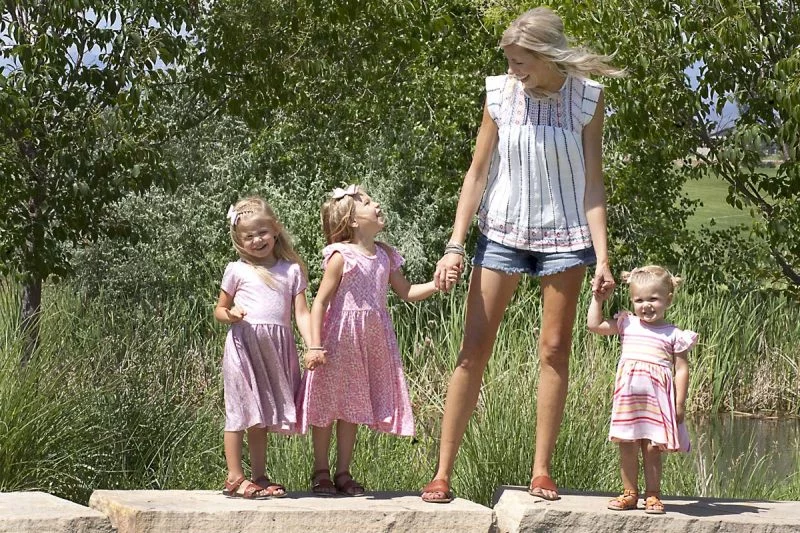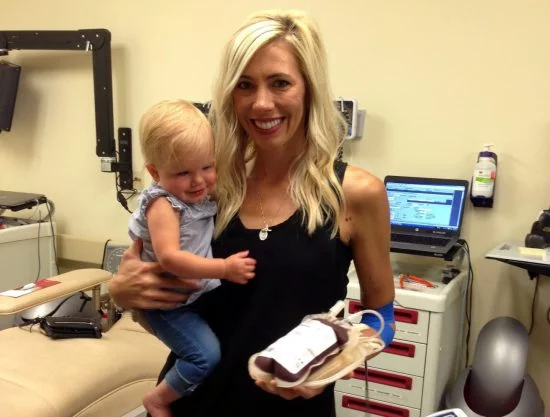And they were off. Two-year-old Eva Trostel followed her sisters, Layne, 3, and Teal,5. The three girls — all in unicorn-patterned swimsuits — squeal as they run together through a water feature of Loveland Sports Park.
Tonya, their mother, stands watch. The weekend before, Eva celebrated her second birthday and Tonya marked that day by donating blood at the UCHealth Garth Englund Blood Donation Center.
Tonya is grateful for her three healthy children and thankful for her own life. On the day Eva was born, Tonya nearly died.

Not long after a photographer snapped a family photo with a glowing Tonya holding Eva, dad leaning in and older sisters perched on a hospital bed — Tonya began to hemorrhage from a rare but dangerous pregnancy complication called placenta accreta. She needed an emergency hysterectomy.
Tonya always wanted a large family, and in her mind three kids was not enough. She was one of six. Only hours after Eva was born, she knew she would never be able to birth another child.

“I feel like the first year after Eva’s birth was such a blur that it was hard, but it didn’t affect me as much,” Tonya said.
Her voice cracked as she continued, “This year has been harder and more challenging as I tried to figure out why. The months that come and go, and thinking we’d be having another child right now, those months are the hardest.”
Small-town girl
Tonya grew up in the small eastern Colorado town of Idalia. Being the second oldest of four brothers and one sister likely sparked her motherly instincts. Participating in sports chased away small-town boredom and earned her a scholarship in track to Colorado State University in Fort Collins.
At CSU, she majored in human development and family studies.
“I couldn’t decide between being a nurse or a teacher, but I knew I wanted to work with kids,” she said.
In track, she competed in long jump, high jump, hurdles, javelin and shot put. She also ran the 200- and 800-meter dash. She jogged almost daily — even up to her first pregnancy.

Starting a family
Tonya and her husband, Evan, met in 2010 at a cousin’s wedding and married in 2012. Evan had two siblings and shared Tonya’s desire for a larger family. They found out they were pregnant shortly after their wedding, but sadly, they miscarried. A few months later, they found out they were pregnant again.
Her pregnancy went well, but Teal wouldn’t turn into the correct position as she neared delivery.
“We waited and waited for her to turn, but she never moved from her position,” Tonya recalled. At 39 weeks, doctors scheduled a C-section.
“I was devastated,” she said. “I was really hoping my body would do it naturally, so it was hard to go that route. But everything went smoothly, and I was just happy that she was healthy.”
Teal was born on Feb. 20, 2014 at UCHealth Medical Center of the Rockies in Loveland.
Tonya put aside her teaching career to be a stay-at-home mom, and a year later, she was pregnant again. Because she had a healthy first pregnancy and a C-section only because Teal was breech, Tonya was a good candidate for vaginal birth after cesarean, or VBAC.
Lessons about VBAC

Women who’ve had only one C-section with a low transverse incision are considered for a VBAC. Doctors use an evidence-based formula that considers women’s age, stature, ethnicity and details from previous and current pregnancy to calculate the chance of a successful VBAC, explained Dr. Natalie Rochester, obstetrics and gynecology specialist leading the medical practices at the UCHealth Women’s Care Clinics in Greeley and Loveland.
If a mom develops medical conditions, such as preeclampsia, during pregnancy; if the baby is very large; or if the mom is not showing signs of laboring at 40 weeks, then a C-section may again be necessary because of the risk to mom and baby if the baby is delivered vaginally. Tonya experienced none of those things.
At 39.5 weeks’ gestation, Tonya got a call that her ill grandmother didn’t have much time left. At 3 a.m., Tonya and her family drove 60-some miles to Denver. Tonya’s contractions started as she arrived at her grandmother’s side — but they were far enough apart for her to say goodbye to her grandmother. The Trostels rushed back to UCHealth Medical Center of the Rockies, where Layne, a healthy girl, was born vaginally around 9 p.m. on Nov. 3, 2015.
Tonya bounced back quickly and was out jogging with her girls, taking them to activities and enjoying everything about being a mother. Another year passed, and Tonya was again pregnant.

Again, she was a candidate for VBAC. Tonya didn’t want it any other way, as she felt it gave her a better chance for her dream of a larger family.
“The data shows risk of complications increases with each additional cesarean,” Rochester said.
Tonya’s third pregnancy went well, and she prepared her girls for their new sister: They moved into a room together and practiced being big sisters to their dolls.
The big day
At 39.5 weeks’ gestation and in labor, Tonya again arrived at UCHealth Medical Center of the Rockies. She hadn’t liked the epidural she’d had when Layne was born, so this time Tonya chose an all-natural delivery, and after seven hours of labor, little Eva arrived on June 22, 2017.
“Everything about her labor and delivery was the easiest of my three girls,” Tonya explained. “Until afterwards.”

Attached placenta
Eva was placed on Tonya’s chest for some bonding time while her body was left to deliver the placenta.
But after an hour had passed with doctors working to deliver the placenta — and more pain than Tonya had ever experienced with childbirth — she was told that they’d need to perform a dilation and curettage (D&C).
A D&C is a surgical procedure in which doctors use a special instrument to scrape the uterine lining while the cervix is dilated. It’s used in cases of early miscarriage as well as post-delivery when the placenta doesn’t want to detach from the uterine wall, which is what seemed to be happening to Tonya.
What had gone wrong?
In pregnancy, the placenta develops inside the uterus and provides oxygen and nutrition to the baby; it also removes waste. The placenta connects to the baby through the umbilical cord, and after delivery, the uterus contracts to deliver the placenta. A retained placenta can cause serious bleeding and infection.
In Tonya’s case, her placenta had invaded — not just attached — to her uterine wall, preventing it from being delivered.
Typically, when the placenta implants itself and causes accreta, it attaches to pre-existing damage within the uterus, such as scar tissue from a C-section or an earlier D&C. Past uterine manipulation can increase a woman’s risk for accreta, but there are cases where accreta has occurred in women without previous uterine manipulation, Rochester said.
Waking to a new reality
Tonya doesn’t remember much of what transpired once she was taken for the 7 p.m. D&C surgery, though she remembers waking up afterwards.
“When I woke I was in a panic because I wanted to rip out the ventilator,” she said. Then she saw the clock and her eyes got big: 4 a.m.!

“It was supposed to be a 30-minute surgery,” she said.
That’s when she wrote down her question on paper for her husband: Did I have a hysterectomy?
“He said, ‘yes,’ and I just started bawling,” Tonya said.
During the D&C, Tonya began hemorrhaging.
“They tried several ways to stop the bleeding and nothing was working,” she said. “In order to save my life, they had to get the uterus out.”
Tonya required 11 units of blood. The average human body contains about 11 units of blood.
Returning home
Physically, Tonya was recovering from a vaginal birth and a major surgery. She had three children to care for along with herself. She leaned on her husband, family, church friends and faith to get her through those days. She appreciated that her days were full of activity, as it distracted her from the reality that she would never deliver another child.
Busy was good, she thought — until it wasn’t.
At two weeks old, the family held a baptismal party for Eva. Tonya was busy getting everything together on that hot summer day, when just as the ceremony concluded, she fainted.
“I tried to bounce back after Eva’s birth, but I didn’t,” she said. “I was trying to do too much. I was bad about relaxing. I was bad about asking for help.”

She has difficulty recalling the details of that first year, but knows it is when she began to struggle with anxiety.
“I’d never had it before,” she explained. “I used to be a very social and outgoing person.”
She has found strength in prayer and in her husband. Her drive to be the best she can be has steadied her and helped her triumph.
“Sitting in prayer has been a huge help. And I express myself to my husband, being open to how I’m feeling. And I’ve learned to push myself out of my comfort zone.”
She’s pushed herself in other ways as well.
Bringing blessings to others
After her surgery, Tonya found support and made friends with other women who have had similar experiences (read their stories). They nurture each other through a “Hope for Accreta” Facebook page. On Eva’s first birthday, members from northern Colorado orchestrated a blood drive at UCHealth Medical Center of the Rockies as a way to provide hope for others.
The event not only helped the local Garth Englund Blood Donation Center regain supplies for patients in northern Colorado, it also brought together women from all over Colorado who were affected by accreta.
Tonya will again joined the members of the local “Hope for Accreta” Facebook group to host a blood drive from 10 a.m. to 1 p.m. Sept. 20, 2019 at the Garth Englund Blood Donation Center at UCHealth Medical Center of the Rockies. Sign up for the drive here. Can you donate blood? Learn more…)
She has an at-home business selling girls’ dresses and offers a chance to win a free dress to her customers if they donate blood.

More love to give
Tonya and Evan just started the foster parent process, and Tonya said they will probably consider adoption after their daughters are a bit older.
In the meantime, she’s helping a few other mothers by providing childcare a few days a week.
“I have the time and the space,” she explained. “I wanted to be a blessing to other people.”

She’s also taking care of herself. She’s regaining strength through pelvic-floor therapy, and has begun to enjoy jogging and biking with her daughters.
“I’m now looking forward to the next steps of motherhood,” she said. “The girls are getting more active and seeing that sisterly bond grow, as all three of them are so close. Teal has stepped into that motherly role with her sisters — and Eva just works so hard to keep up — it’s so much fun to watch.”
On a warm summer day a few weeks ago, Tonya watched her daughters hold hands and splash in the water. Tonya felt at ease.
“The way our family dynamics have come together and everyone has their role… it just feels like it is meant to be,” she said. “I do feel really blessed.”
